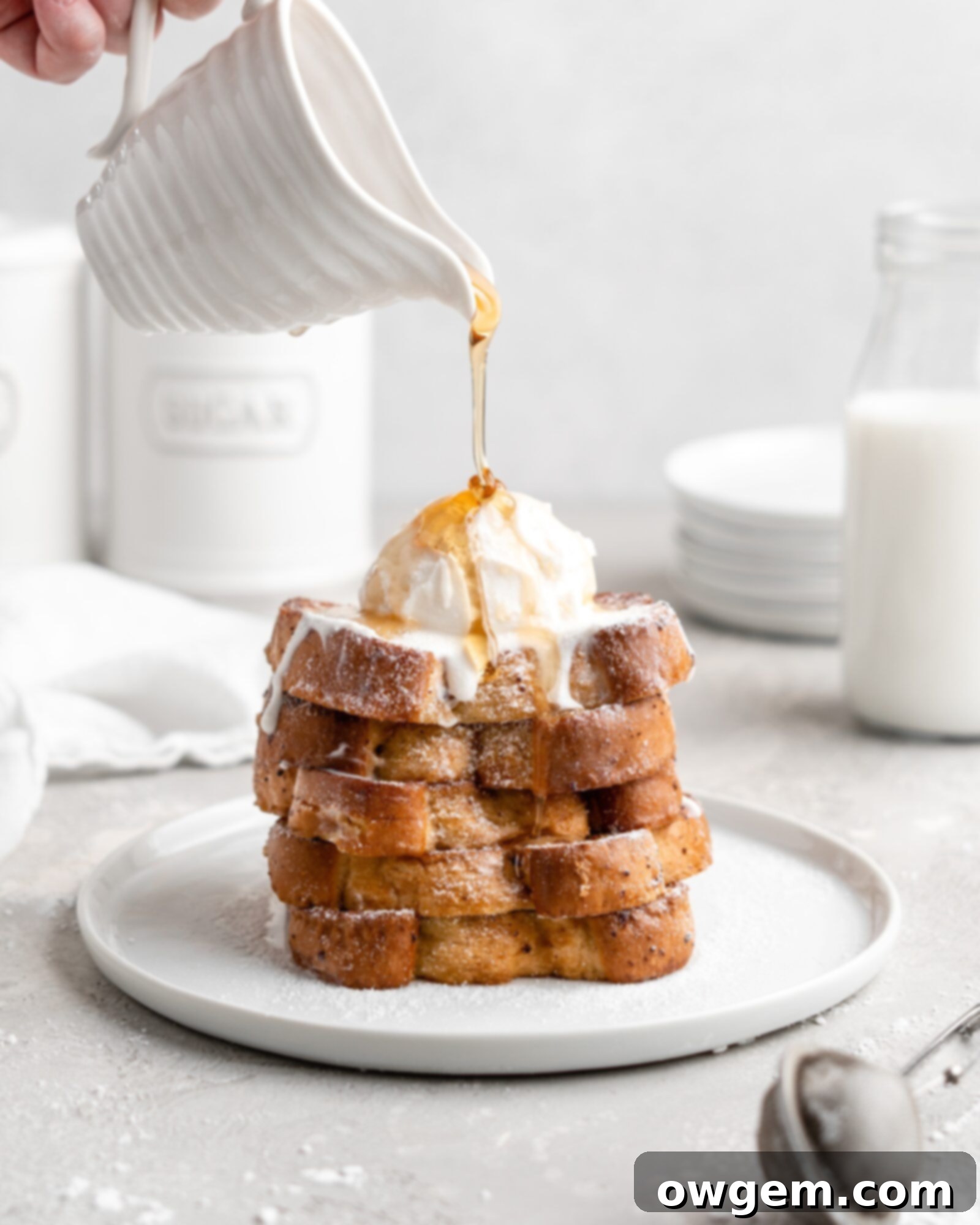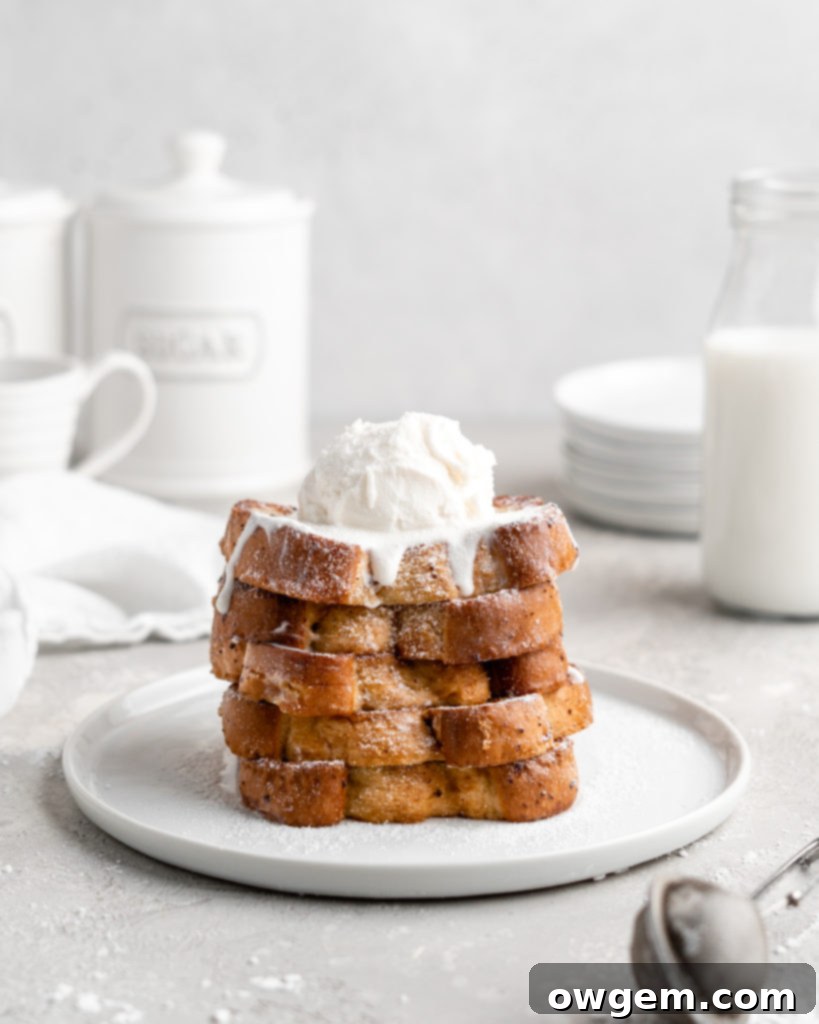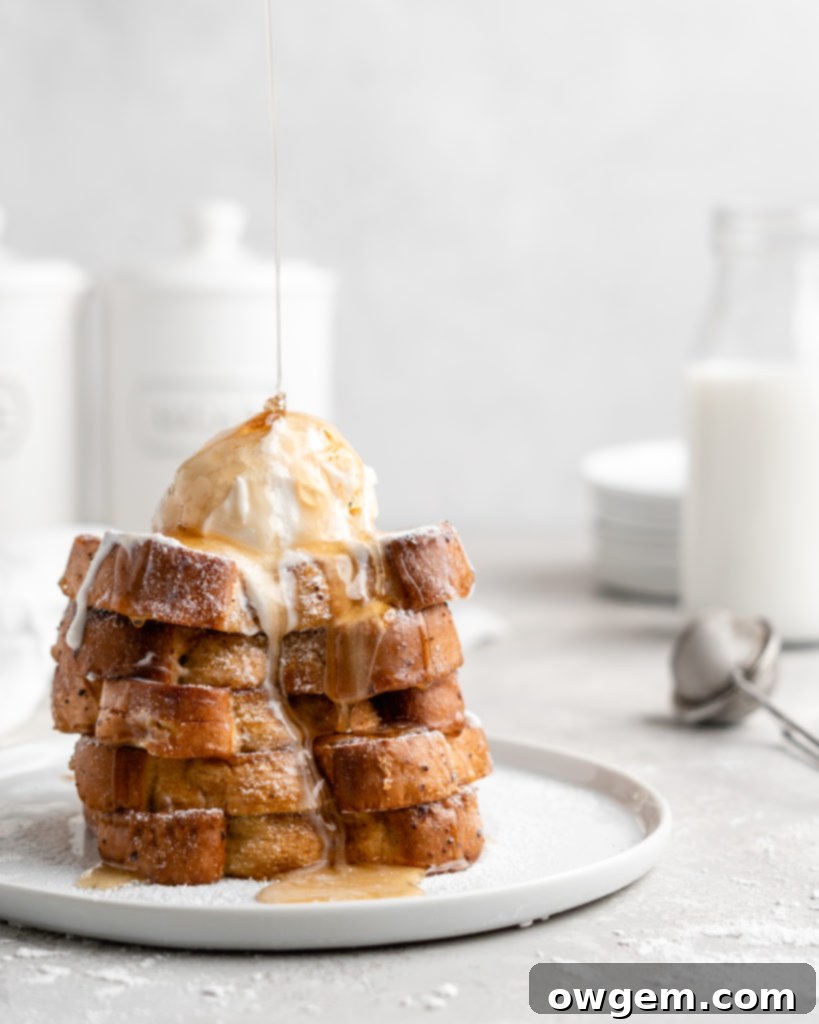Perfect Grand Marnier Buttermilk French Toast: Your Ultimate Gourmet Weekend Brunch Recipe
Updated March 2020 with new photos and enhanced tips for an even better breakfast experience!
Imagine sinking your teeth into thick, incredibly soft, yet wonderfully structured pieces of French bread, each bite bursting with flavor. Our Grand Marnier infused buttermilk custard creates a French Toast that transcends the ordinary. It’s a culinary journey that balances unique, sophisticated notes with the comforting, nostalgic taste of a classic breakfast. Prepare to elevate your weekend mornings with this truly perfect Buttermilk French Toast!
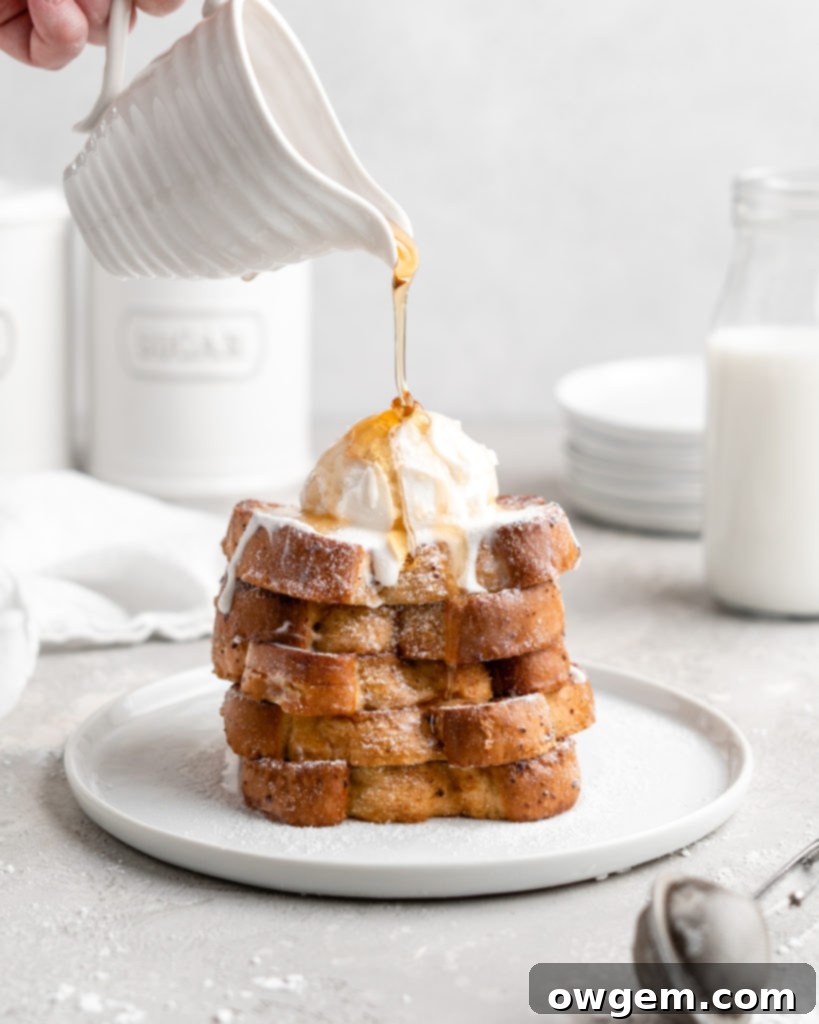
For years, French Toast was a culinary enigma for me. It was something I’d whip up out of necessity when an orphaned loaf of white bread was teetering on the edge of staledom, destined for the trash if not repurposed quickly. My “recipe” was a rudimentary concoction: an egg, a splash of skim milk, a sprinkle of cinnamon, and a quick dip for those thin, unassuming slices. While this method certainly salvaged bread and satisfied a hunger pang in a pinch, it consistently fell short of the dreamy French Toast served in restaurants. Those restaurant versions were always so incredibly flavorful, lusciously moist, and beautifully pillowy, yet they miraculously maintained a perfect structure and satisfying golden crispness on the outside.
“It must be the bread,” I mused, convinced that the foundation was the key. So, I invested in a gorgeous, fresh loaf of artisan French bread from our local bakery, eager to replicate that restaurant-quality experience. To my dismay, the result was a soggy, disappointing mess! “Ah,” I realized, “the bread needs to be stale.” Learning from my mistake, I tried again with stale bread, hoping for redemption. This time, however, the French Toast emerged dry and uninspiring. It seemed I was trapped in a perpetual cycle of culinary frustration, unable to strike that elusive balance between moistness and structure. Little did I know, the secret to truly perfect French Toast lay not just in the bread, but in a series of nuanced techniques and a carefully crafted custard – elements I was about to discover through dedicated research and delicious experimentation.
Unlock the Secrets: Essential Tips for Perfect Buttermilk French Toast
After countless trials, meticulous research, and many delectable tastings, I uncovered the true artistry behind creating French Toast that rivals any restaurant. It’s far more intricate than simply dipping bread in egg! I’ve distilled my findings into a comprehensive set of tips and tricks, designed to help you achieve the ultimate Buttermilk French Toast with a truly exceptional recipe. Follow these guidelines, and you’ll transform your breakfast game forever.
- Embrace Stale Bread for Superior Absorption. This is perhaps the most critical tip for avoiding soggy French Toast. Stale bread, with its reduced moisture content, acts like a sponge, allowing it to absorb the custard more effectively and uniformly without becoming waterlogged. Fresh bread, by contrast, will quickly become saturated and fall apart when cooked. To achieve perfectly stale bread, simply slice your chosen loaf the night before and leave it uncovered on your kitchen counter for at least 8 hours. The ambient air will naturally dry it out. If you’re short on time or forgot this crucial step, don’t despair! Cut the loaf into slices and place them in a preheated oven at 250°F (120°C) for approximately 20-25 minutes, or until slightly firm and dried out. This quick method will prepare your bread for optimal custard absorption.
- Choose the Right Bread and Cut Thick Slices. The foundation of exceptional French Toast is robust bread. Varieties like Brioche, Challah, and a classic French loaf are ideal choices due to their sturdy crumb and ability to hold their shape after soaking and cooking. Avoid thinly sliced sandwich bread, which will inevitably become limp and mushy. When slicing, aim for a thickness of ¾ inch to 1 inch. This precise thickness ensures that the bread can absorb enough of the rich custard to be incredibly flavorful and moist throughout, without becoming either too dry in the center (if too thick) or completely soggy and fragile (if too thin). Thick slices also contribute to that luxurious, “pillow-ey” texture we all crave.
- Strain Your Beaten Eggs for a Silky Custard. Nobody wants unexpected lumps of cooked egg white in their otherwise smooth and delicious French Toast. Straining your beaten eggs through a fine-mesh sieve is a simple yet effective step that guarantees a uniformly silky custard. This process removes any chalazae (the stringy white bits that anchor the yolk) or unincorporated egg white, preventing those unappealing streaks or rubbery textures in the final product. A smooth custard also ensures a more consistent flavor profile, free from any overly “eggy” notes that can sometimes occur from undissolved egg whites.
- Opt for Buttermilk Instead of Regular Milk for Enhanced Flavor and Texture. This is a game-changer! The unique qualities of buttermilk significantly elevate French Toast. Its higher viscosity compared to regular milk creates a thicker, richer custard that clings beautifully to the bread, resulting in a more indulgent and satisfying bite. Beyond texture, buttermilk introduces a subtle tang and depth of flavor that complements the sweetness and spices in the recipe, adding an extra dimension that regular milk simply cannot provide. Make sure to use full-fat buttermilk for the best results, as lower-fat versions can lead to a thinner custard.
- Bring Your Custard to Room Temperature (If Time Allows). While not strictly mandatory for a good outcome, using a room temperature custard can make a noticeable difference in achieving truly perfect French Toast. A reduced temperature difference between the bread (which ideally should also be at room temperature) and the pan minimizes the shock to the eggs, thereby reducing the likelihood of them congealing or scrambling when they hit the hot pan. This helps ensure a smooth, even cook. If you plan ahead, simply set your ingredients out on the counter about 30 minutes before mixing. If you’re in a hurry, you can gently warm the combined custard ingredients in a bowl over a bain-marie (a bowl set over a pot of simmering water) for a few minutes, stirring occasionally, until it loses its chill.
- Crucial Soak and Rest: 30-40 Seconds Per Side, Plus 5 Minutes Resting. This two-part soaking method is absolutely vital for achieving uniformly moist and flavorful French Toast. First, immerse each bread slice in the custard for 30-40 seconds per side (30 seconds for ¾” slices, 40 seconds for 1″ slices). This extended soak allows the thick, rich buttermilk custard to penetrate deeply into the bread. Immediately after soaking, transfer the slices to a wire rack set over a baking sheet and let them rest for an additional 5 minutes. This resting period is transformative: it allows the absorbed custard to fully distribute and soak into the very center of the bread, preventing a dry core and creating that coveted “pillow-ey” interior without any sogginess.
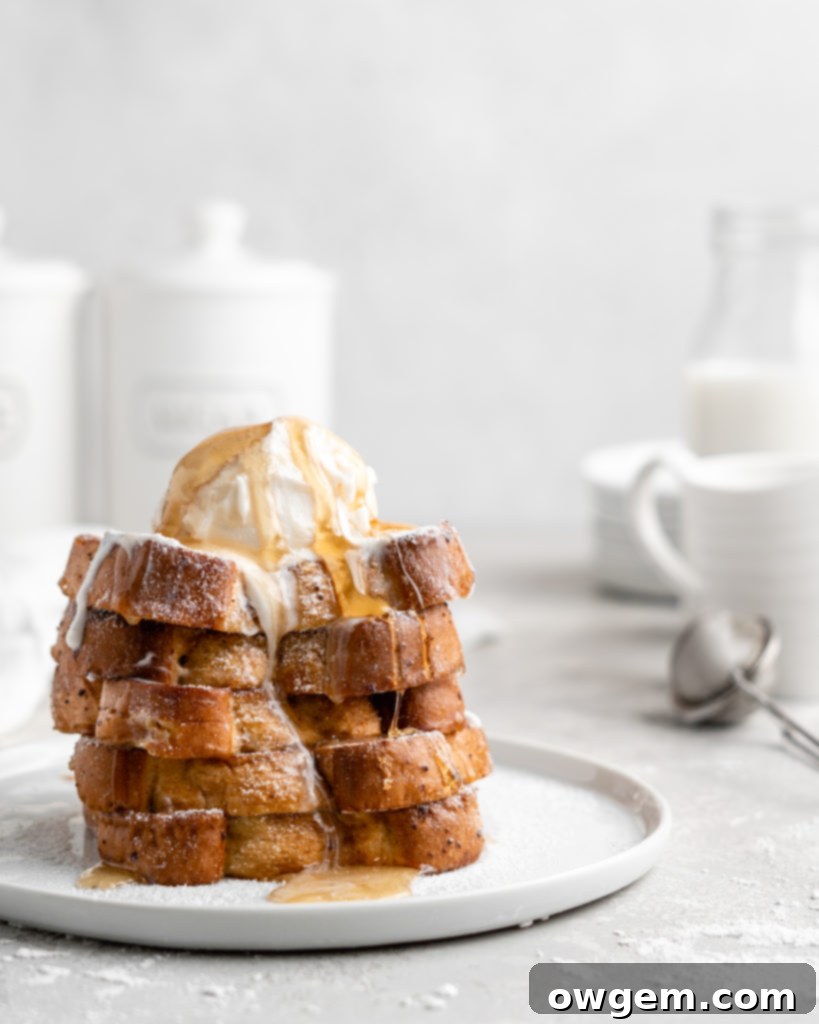
- Fry with a Blend of Butter AND Oil for Optimal Flavor and Browning. For the best of both worlds – rich flavor and a beautiful golden-brown crust – use a combination of butter and a neutral-flavored oil for frying. Butter imparts an unparalleled depth of flavor and a lovely aroma to your French Toast. However, butter also has a relatively low smoke point, meaning it can burn quickly and lead to a bitter taste. By adding a high smoke point, neutral oil (like canola, grapeseed, or even vegetable oil), you effectively raise the overall smoke point of your frying fat. This allows the French Toast to cook evenly and achieve a perfect golden hue without the butter scorching, ensuring both delicious taste and appealing appearance.
- Avoid Overzealous Heat: Cook Low and Slow. Patience is key when frying French Toast. Resist the temptation to cook it on high heat to speed up the process. High heat will quickly burn the exterior of the bread, creating an unappetizing dark crust, while leaving the interior undercooked, runny, and unset. Instead, preheat your pan to medium-low heat and maintain a consistent, gentle temperature. This allows the French Toast to cook through evenly, achieving a beautifully golden-brown crust and a fully set, fluffy interior.
- Utilize the Oven for Perfect Setting and Warmth (Optional, but Recommended). While you can serve French Toast straight from the pan, a quick stint in a preheated oven at 375°F (190°C) for 5 minutes after frying can elevate the results. This brief baking period allows the custard to fully set in the center of the bread, enhancing its overall structure and ensuring every bite is perfectly cooked. It also conveniently keeps all your slices warm until you’re ready to serve, a huge bonus when feeding a crowd. If hunger can’t wait, feel free to serve them as they come off the pan – they’ll still be delicious!
- Don’t Skip the Grand Marnier (Seriously!). While you *can* omit the alcohol if absolutely necessary, I wholeheartedly urge you to try this recipe with Grand Marnier. This orange-flavored liqueur adds a truly exquisite, beautiful dimension to the French Toast that is hard to replicate. During the cooking process, the alcohol content evaporates almost entirely, leaving behind a delicate, slightly citrusy, and deeply aromatic orange essence. This subtle orange note wonderfully complements the warm spices like cinnamon and nutmeg in the custard, creating a sophisticated flavor profile that will surprise and delight your taste buds. Once you experience French Toast prepared this way, you’ll understand why I’ve never gone back!
- Customize the Sugar Content to Your Liking. The beauty of this recipe lies in its adaptability, especially when it comes to sweetness. The suggested amount of sugar (1/3 cup) provides a balanced sweetness that works well with various toppings. If you prefer to enjoy your Buttermilk French Toast with minimal additional toppings – perhaps just a pat of butter, a dollop of whipped cream, or a sprinkle of powdered sugar – you might enjoy a slightly sweeter batter. In that case, increasing the sugar to ½ cup is an excellent choice. Conversely, if you’re like me and love to douse your French Toast generously with rich maple syrup, fresh fruit, or sweet jams, you can easily reduce the sugar in the batter to about ¼ cup to avoid an overly sweet final product. Taste preference is personal, so feel free to adjust!
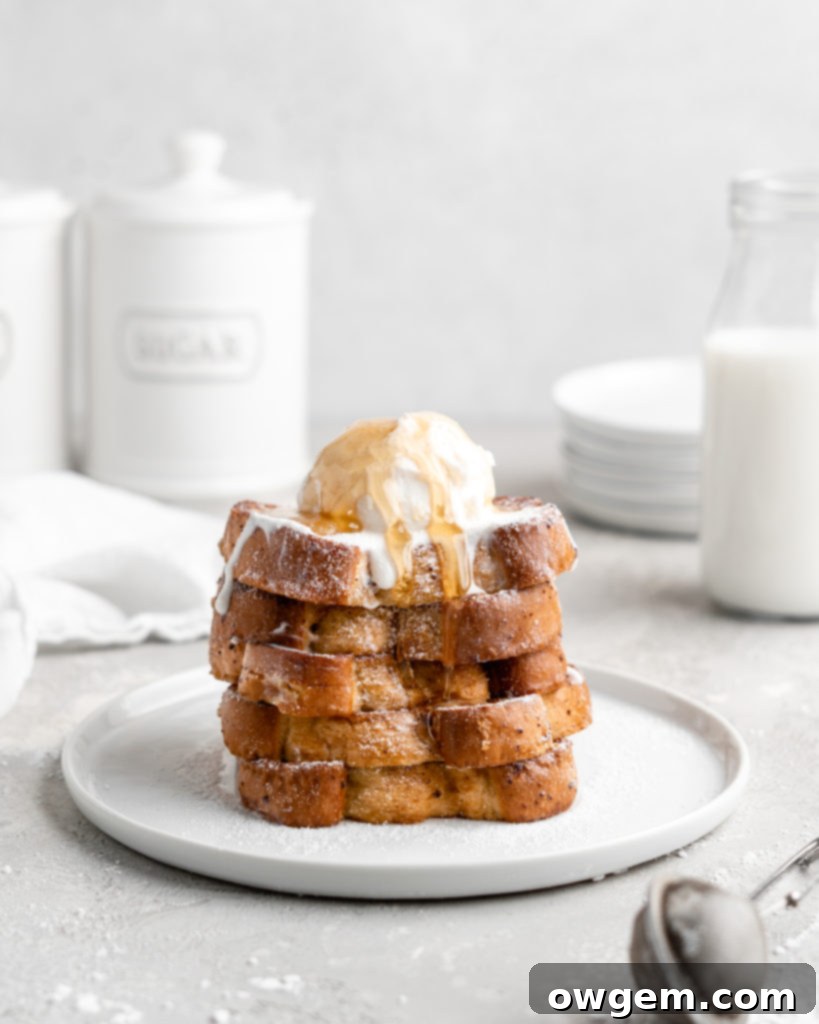
Serving Suggestions for Your Gourmet French Toast
Once your Grand Marnier Buttermilk French Toast is cooked to perfection, the possibilities for serving are endless! Classic maple syrup is always a winner, but don’t stop there. Consider a dusting of powdered sugar, a dollop of freshly whipped cream, or a scoop of vanilla bean ice cream for an indulgent touch. Fresh berries like strawberries, blueberries, or raspberries add a lovely tart contrast and vibrant color. A drizzle of chocolate sauce or a sprinkle of toasted nuts can also elevate this dish into a truly memorable dessert-for-breakfast experience. For an extra citrusy kick, a thin slice of orange zest or a candied orange peel would beautifully echo the Grand Marnier notes.
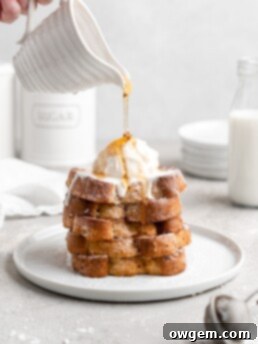
Get the Recipe:
Buttermilk French Toast with Grand Marnier
Pin
Rate
Ingredients
- 1 Loaf Very Stale French Bread or Italian Bread, cut into 3/4″ – 1″ slices †
- 6 Large Eggs
- 1 cup Full Fat Buttermilk, ††
- 1/2 cup Half & Half
- 1/3 cup Granulated Sugar
- 1 tbsp Grand Marnier (orange liqueur)
- 1 tsp Vanilla Extract
- 1 tsp Ground Cinnamon
- Dash of Freshly Grated Nutmeg
- Pinch of Salt
Instructions
-
Preheat your oven to 375°F (190°C). This step is optional, primarily used for baking the French Toast after frying to ensure it’s perfectly set and kept warm.
-
In a large bowl, whisk the eggs vigorously until they are thoroughly beaten and light yellow. Using a fine-mesh sieve, strain the beaten eggs into another bowl to remove any chalazae or large chunks of egg white. This crucial step ensures a smooth, silky custard. Then, add the buttermilk, half & half, sugar, Grand Marnier, vanilla extract, cinnamon, nutmeg, and salt to the strained eggs. Whisk everything together until all ingredients are well combined and the sugar is dissolved. Transfer this velvety custard into a shallow baking dish (approximately 9″x13″ or similar size) that is wide enough to comfortably fit your bread slices for soaking.
-
Prepare a baking sheet by placing a wire cooling rack on top; this will be used for resting the soaked bread. Carefully place your stale bread slices into the custard batter, ensuring each side is fully submerged. Allow each side to soak for 30-40 seconds (opt for 30 seconds for ¾” thick slices and 40 seconds for 1” thick slices). The extended soak is key for a moist interior. Once soaked, gently transfer the bread slices onto the prepared wire rack. Let the soaked bread rest on the racks for approximately 5 minutes. This resting period allows the custard to evenly penetrate the center of the bread, preventing sogginess and ensuring a perfectly uniform texture. While the bread rests, begin preheating your frying pan.
-
Place a large frying pan (a griddle or cast-iron skillet works wonderfully) over medium-low heat and allow it to preheat thoroughly. Once hot, add ½ tbsp of butter and ½ tbsp of neutral-flavored oil (like canola or grapeseed oil) to the pan. Swirl to combine and allow the butter to melt completely and its foam to subside, but not burn. Carefully add the soaked bread slices to the pan, ensuring not to overcrowd it. Cook for about 3 minutes per side, or until each side is beautifully golden brown and the French Toast feels firm yet springy to the touch. Repeat this process with the remaining bread, adding more butter and oil as needed for each batch.
-
Optional Finishing Step: After all slices have been fried to a golden perfection, return them to the wire rack on the baking sheet. Place the entire rack with the French Toast into your preheated 375°F (190°C) oven and bake for 5 minutes. This final baking step helps to further set the custard in the center, guaranteeing a truly fluffy and uniformly cooked interior, and keeps all your French Toast warm for serving. Serve immediately with your favorite toppings and enjoy your gourmet breakfast!
Notes
†† For the richest and thickest custard, always use full-fat buttermilk. Lower fat varieties will result in a thinner custard that doesn’t coat the bread as effectively, potentially leading to a less satisfying texture.
Source: Adapted from Martha Stewart
